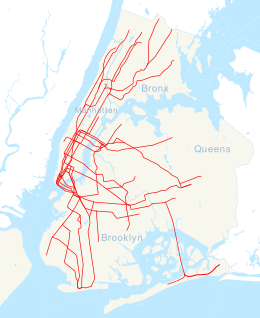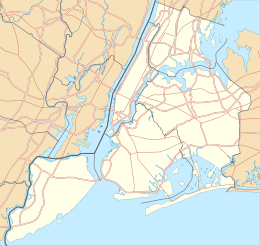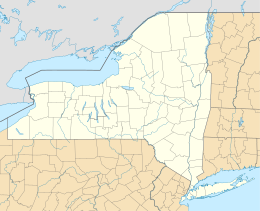railroad.wikisort.org - Station
The Clark Street station is a station on the IRT Broadway–Seventh Avenue Line of the New York City Subway. It is located at Clark Street and Henry Street in Brooklyn Heights, Brooklyn. It is served by the 2 train at all times and the 3 train at all times except late nights.
Clark Street | ||||||||||||||||||||||||||||||||||||||||||||||||||||||||||||||||||||||||||||||||||
|---|---|---|---|---|---|---|---|---|---|---|---|---|---|---|---|---|---|---|---|---|---|---|---|---|---|---|---|---|---|---|---|---|---|---|---|---|---|---|---|---|---|---|---|---|---|---|---|---|---|---|---|---|---|---|---|---|---|---|---|---|---|---|---|---|---|---|---|---|---|---|---|---|---|---|---|---|---|---|---|---|---|---|
 Platform level | ||||||||||||||||||||||||||||||||||||||||||||||||||||||||||||||||||||||||||||||||||
| Station statistics | ||||||||||||||||||||||||||||||||||||||||||||||||||||||||||||||||||||||||||||||||||
| Address | Clark Street & Henry Street Brooklyn, NY 11201 | |||||||||||||||||||||||||||||||||||||||||||||||||||||||||||||||||||||||||||||||||
| Borough | Brooklyn | |||||||||||||||||||||||||||||||||||||||||||||||||||||||||||||||||||||||||||||||||
| Locale | Brooklyn Heights | |||||||||||||||||||||||||||||||||||||||||||||||||||||||||||||||||||||||||||||||||
| Coordinates | 40.6974°N 73.9931°W | |||||||||||||||||||||||||||||||||||||||||||||||||||||||||||||||||||||||||||||||||
| Division | A (IRT)[1] | |||||||||||||||||||||||||||||||||||||||||||||||||||||||||||||||||||||||||||||||||
| Line | IRT Broadway–Seventh Avenue Line | |||||||||||||||||||||||||||||||||||||||||||||||||||||||||||||||||||||||||||||||||
| Services | 2 3 | |||||||||||||||||||||||||||||||||||||||||||||||||||||||||||||||||||||||||||||||||
| Transit | ⛴ NYC Ferry: East River and South Brooklyn routes (at Old Fulton Street and Furman Street) | |||||||||||||||||||||||||||||||||||||||||||||||||||||||||||||||||||||||||||||||||
| Structure | Underground | |||||||||||||||||||||||||||||||||||||||||||||||||||||||||||||||||||||||||||||||||
| Platforms | 1 island platform | |||||||||||||||||||||||||||||||||||||||||||||||||||||||||||||||||||||||||||||||||
| Tracks | 2 | |||||||||||||||||||||||||||||||||||||||||||||||||||||||||||||||||||||||||||||||||
| Other information | ||||||||||||||||||||||||||||||||||||||||||||||||||||||||||||||||||||||||||||||||||
| Opened | April 15, 1919 | |||||||||||||||||||||||||||||||||||||||||||||||||||||||||||||||||||||||||||||||||
| Accessible | ||||||||||||||||||||||||||||||||||||||||||||||||||||||||||||||||||||||||||||||||||
| Opposite- direction transfer | Yes | |||||||||||||||||||||||||||||||||||||||||||||||||||||||||||||||||||||||||||||||||
| Former/other names | Clark Street–Brooklyn Heights | |||||||||||||||||||||||||||||||||||||||||||||||||||||||||||||||||||||||||||||||||
| Traffic | ||||||||||||||||||||||||||||||||||||||||||||||||||||||||||||||||||||||||||||||||||
| 2019 | 1,781,419[2] | |||||||||||||||||||||||||||||||||||||||||||||||||||||||||||||||||||||||||||||||||
| Rank | 259 out of 424[2] | |||||||||||||||||||||||||||||||||||||||||||||||||||||||||||||||||||||||||||||||||
| ||||||||||||||||||||||||||||||||||||||||||||||||||||||||||||||||||||||||||||||||||
| ||||||||||||||||||||||||||||||||||||||||||||||||||||||||||||||||||||||||||||||||||
| ||||||||||||||||||||||||||||||||||||||||||||||||||||||||||||||||||||||||||||||||||
| ||||||||||||||||||||||||||||||||||||||||||||||||||||||||||||||||||||||||||||||||||
| ||||||||||||||||||||||||||||||||||||||||||||||||||||||||||||||||||||||||||||||||||
History
20th century
On April 15, 1919, the Clark Street Tunnel opened, and this station opened with it, extending West Side Line express trains from Wall Street on the other side of the East River to Atlantic Avenue via a new connection at Borough Hall. The connection doubled the capacity between Manhattan and Brooklyn and eased congestion from the Joralemon Street Tunnel. Direct express service to Times Square was provided to the inhabitants of Brooklyn for the first time as a result.[3]
On April 30, 1930, the New York State Transit Commission ordered the installation of a third elevator at the station. This elevator went into service on November 25, 1931.[4]
The city government took over the IRT's operations on June 12, 1940.[5][6] During the 1964–1965 fiscal year, the platforms at Clark Street, along with those at four other stations on the Broadway–Seventh Avenue Line, were lengthened to 525 feet (160 m) to accommodate a ten-car train of 51 feet (16 m) IRT cars.[7]
In 1981, the Metropolitan Transportation Authority (MTA) listed the station among the 69 most deteriorated stations in the subway system.[8] On February 8, 1983, renovations made to the station as part of the MTA's Adopt-A-Station Program were unveiled. The $260,000 cost was evenly split between public and private agencies. Neighborhood maps were added to the station as part of the project.[9]
In 1984–1985, construction was completed to rehabilitate the station. The station was chosen for renovation in 1979, and design work was done in early 1982. Artwork was to be contributed to the design. The platform was refinished, new lights and new signs were installed, and new painting was done. The project was projected to cost $1.25 million but went over budget. The construction was projected to begin in January 1984, but it quickly fell behind schedule. Issues with the contractors contributed to the delays.[10]
21st century
The elevators were repaired in 2000, necessitating a four-month closure, and again in 2007.[11] In January 2017, Clark Street became the last underground station in the New York City Subway to receive Transit Wireless cell phone service.[12]
The MTA announced in 2019 that the station's elevators would need to be replaced again in 2020 because they frequently broke down. At the time, the MTA estimated that repairs might take eight months to three years depending on whether the station is fully closed or remains open.[13][14][15] The elevators have never been replaced since they were originally installed: two of the elevators date from the station's opening in 1919, while the third dates from 1931.[13] In September 2021, the MTA announced that the station would again be closed for several months for elevator replacement and structural repairs.[16] The station was closed on November 3, 2021,[17][18] and reopened on May 5, 2022.[19][20]
Station layout
| G | Street level | Exit/entrance, fare control, station agent Elevators in station house within Hotel St. George. Note: Platform level is not accessible |
| M | Clark Street Passage | Elevators to street, staircases to platform |
| P Platform level |
Northbound | ← ← |
| Island platform | ||
| Southbound | | |

Clark Street is geographically the westernmost station in Brooklyn on the Broadway–Seventh Avenue Line. It has one island platform and two tracks. Due to the deep-bore tunneling used to construct this part of the line, the station's walls are rounded. On the walls of the platforms are mosaics of sailing ships and large name panels reading Clark Street–Brooklyn Heights.
Exit
The platform has two staircases in the center that go up to a passageway, which leads to three elevators. The floor of the passageway contains a 1987 artwork titled Clark Street Passage by Ray Ring and the elevators go up to fare control, which is on the first floor of the now-defunct Hotel St. George.
The station is not fully ADA-accessible, since there are no elevators or ramps that lead to the platform.[18] The fare control area contains a small arcade of businesses[17][21] and two doors that led to the former lobby and checking room of the hotel. The station's two entrances have awnings that read "Hotel St. George."[22]
This is one of only three stations in the subway system that can be accessed solely by elevators. The other two—168th Street and 181st Street—are also on the Broadway–Seventh Avenue Line, albeit in Upper Manhattan.[13] An emergency stairwell exists between elevators 1 and 2 from the passageway up to fare control, but it is rarely used and consists of an 80-foot (24.3-meter) climb.[13][23]
A 2008 study by Brooklyn Community Board 6 examined the possibility of creating a new entrance to the station from Brooklyn Bridge Park; however, it was deemed economically unfeasible.[24]
References
- "Glossary". Second Avenue Subway Supplemental Draft Environmental Impact Statement (SDEIS) (PDF). Vol. 1. Metropolitan Transportation Authority. March 4, 2003. pp. 1–2. Archived from the original (PDF) on February 26, 2021. Retrieved January 1, 2021.
- "Facts and Figures: Annual Subway Ridership 2014–2019". Metropolitan Transportation Authority. 2020. Retrieved May 26, 2020.
- "OPEN CLARK STREET LINE.; New Route Doubles Subway Service Between the Two Boroughs" (PDF). Archived (PDF) from the original on December 17, 2021. Retrieved August 26, 2016.
- Eleventh Annual Report For The Calendar Year 1931. New York State Transit Commission. 1922. p. 80.
- "City Transit Unity Is Now a Reality; Title to I.R.T. Lines Passes to Municipality, Ending 19-Year Campaign". The New York Times. June 13, 1940. ISSN 0362-4331. Archived from the original on January 7, 2022. Retrieved May 14, 2022.
- "Transit Unification Completed As City Takes Over I. R. T. Lines: Systems Come Under Single Control After Efforts Begun in 1921; Mayor Is Jubilant at City Hall Ceremony Recalling 1904 Celebration". New York Herald Tribune. June 13, 1940. p. 25. ProQuest 1248134780.
- Annual Report 1964–1965. New York City Transit Authority. 1965.
- Gargan, Edward A. (June 11, 1981). "AGENCY LISTS ITS 69 MOST DETERIORATED SUBWAY STATIONS". The New York Times. Archived from the original on March 31, 2019. Retrieved August 13, 2016.
- Jones, Michael (February 9, 1983). "'Adopt-A-Station' scores a victory" (PDF). News World. Archived (PDF) from the original on March 17, 2022. Retrieved March 4, 2019.
- Daley, Suzanne (March 8, 1985). "YEAR OF ELAYS PLAGUE RENOVATION OF A BROOKLYN IRT STATION". The New York Times. ISSN 0362-4331. Archived from the original on January 5, 2017. Retrieved August 28, 2016.
- Karni, Annie (April 30, 2007). "Brooklyn's Clark Street Elevator Failed 400 Times Over Two Years". The New York Sun. Archived from the original on October 8, 2019. Retrieved October 8, 2019.
- Frost, Mary (January 6, 2017). "Last NYC subway station to get cellphone service going live Monday at Clark Street in Brooklyn". Brooklyn Daily Eagle. Archived from the original on January 7, 2017. Retrieved January 7, 2017.
- Carlson, Jen (September 17, 2019). "Andy Byford Wants Full Eight Month Closure Of Brooklyn Subway Station To Fix Elevators From Hell". Gothamist. Archived from the original on October 8, 2019. Retrieved October 8, 2019.
- "Clark Street station closure 'not a done deal,' says MTA official". Brooklyn Eagle. September 17, 2019. Archived from the original on October 8, 2019. Retrieved October 8, 2019.
- Rana, Urshila (September 17, 2019). "MTA Breaks Silence On Clark Street Subway Station Closure". Kings County Politics. Archived from the original on September 30, 2020. Retrieved October 8, 2019.
- "Brooklyn Heights' Clark Street station to close for months". Brooklyn Eagle. September 13, 2021. Archived from the original on September 16, 2021. Retrieved September 16, 2021.
- Brendlen, Kirstyn (October 7, 2021). "Clark Street station businesses brace for eight-month closure". Brooklyn Paper. Archived from the original on May 11, 2022. Retrieved May 6, 2022.
- Guse, Clayton (October 4, 2021). "MTA to close NYC subway station for 4-plus months to fix elevators, work won't make it wheelchair accessible". New York Daily News. Archived from the original on May 6, 2022. Retrieved May 6, 2022.
- "Jubilant commuters celebrate quiet re-opening of Clark St. subway". Brooklyn Eagle. May 5, 2022. Archived from the original on May 5, 2022. Retrieved May 5, 2022.
- Guse, Clayton (May 5, 2022). "MTA reopens Clark St. subway station in Brooklyn Heights with new elevators after 6-month closure". New York Daily News. Archived from the original on May 6, 2022. Retrieved May 6, 2022.
- Spivack, Caroline (February 7, 2022). "The Impossibility of Running a Business in a Closed Subway Station". Curbed. Archived from the original on May 6, 2022. Retrieved May 6, 2022.
- "MTA Neighborhood Maps: Downtown Brooklyn and Borough Hall" (PDF). mta.info. Metropolitan Transportation Authority. 2015. Archived (PDF) from the original on July 24, 2015. Retrieved August 2, 2015.
- "Clark Street subway station elevator must be replaced, BP Adams says". AMNY. October 2, 2018. Archived from the original on March 7, 2022. Retrieved March 7, 2022.
- "Brooklyn Bridge Park Transportation+Access Study" (PDF). Brooklyn Community Board 6. 2008. Archived from the original (PDF) on July 8, 2015. Retrieved July 7, 2015.
Further reading
- Stookey, Lee (1994). Subway ceramics : a history and iconography of mosaic and bas relief signs and plaques in the New York City subway system. Brattleboro, Vt: L. Stookey. ISBN 978-0-9635486-1-0. OCLC 31901471.
External links
- nycsubway.org – Brooklyn IRT: Clark Street
На других языках
- [en] Clark Street station
[ru] Кларк-стрит (линия Бродвея и Седьмой авеню, Ай-ар-ти)
«Кларк-стрит» (англ. Clark Street) — станция Нью-Йоркского метрополитена, расположенная на линии Бродвея и Седьмой авеню, Ай-ар-ти. На станции останавливаются маршруты 2 (круглосуточно) и 3 (круглосуточно, кроме ночи). Она представлена островной платформой, обслуживающей два пути.Другой контент может иметь иную лицензию. Перед использованием материалов сайта WikiSort.org внимательно изучите правила лицензирования конкретных элементов наполнения сайта.
WikiSort.org - проект по пересортировке и дополнению контента Википедии



